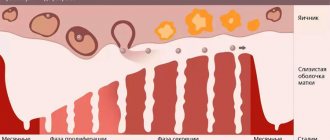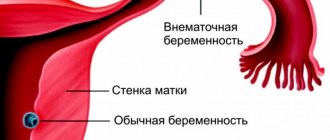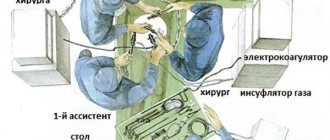The female reproductive system has a rather complex and unique structure. The composition contains many different elements that in one way or another affect sexual functions. If pathological changes occur in any department that require surgical intervention, the operation of this system will definitely be disrupted.
Sometimes reproductive organs are removed during surgery. All this undoubtedly affects the physiological and psychological state of a woman. If a bilateral oophorectomy was previously performed, a logical question arises: if there are no ovaries, will menstruation occur?
After a woman of reproductive age undergoes removal of the uterine appendages on both sides, she may experience various alarming symptoms throughout the entire recovery period. First of all, the operation affects blood pressure indicators, which quite often show data exceeding the norm.
Against this background, a febrile state may develop, or a feeling of chills appears, and thinning of the veins is noted. Women quite often notice that they are bothered by headaches. Violations are also of a psychological type. Patients often fall into depressive states, they experience neuroses and emotional disorders.
Changes
After bilateral ovarian removal, women are diagnosed with postoperative menopause. This condition is serious, because against the backdrop of the fact that the fairer sex is experiencing the loss of reproductive function, she begins to experience all the manifestations of the menopausal period. This is due to insufficient production of female sex hormones.
During the first 14-21 days after surgery, the body will begin to rebuild. Initially, it will be quite difficult for a woman to experience these sensations, but over the course of 2-3 months, severe symptoms will gradually decrease. However, other unpleasant conditions will develop.
After bilateral removal of the ovaries, the body of the fairer sex will be saturated with estrogens due to the fact that they will be produced by the adrenal glands. In addition, a small content of this substance is observed in adipose tissue.
If there is very little hormone in the blood of a woman of reproductive age, then the development of other serious problems is possible. In particular, patients develop artificial menopause, and against its background there will be atherosclerosis, osteoporosis, obesity, and there will also be problems with the veins of the lower extremities. Doctors often call this condition the post-castration period.
Menses
If you clearly answer the question of whether menstruation occurs in the absence of ovaries on both sides, then doctors will definitely say that regular bleeding stops. This is due to the fact that in this state, childbearing and reproductive functions are no longer carried out. In situations where menstrual flow persists after surgery, it is necessary to contact a gynecologist as soon as possible.
In most cases, the reason for removal of the ovaries is the development of cancer, that is, the formation of a malignant tumor formation. If hormone replacement therapy was subsequently prescribed, taking medications of this type can cause bleeding, which women often mistake for menstruation.
Bilateral removal of the uterine appendages is a very serious operation that greatly destabilizes the emotional and mental state of a woman. Such patients are advised to seek help not only from a gynecologist, but also from a psychologist, who will help them recover and prevent them from falling into depression.
For the treatment of many serious gynecological diseases or their diagnosis, the laparoscopic method is used. Menstruation after ovarian laparoscopy occurs in each woman depending on her individual characteristics. To prevent early complications, it is necessary to monitor changes in the body and possible menstrual irregularities that may appear after surgery. Laparoscopy rarely leads to adverse consequences, but if abnormalities are detected, consultation with a specialist is required.
Why is there a delay in menstruation after an ectopic pregnancy?
Menstruation after an ectopic pregnancy begins in most women with a slight delay, since the period of restoration of the menstrual cycle directly depends on the psychological and physiological state of the woman. The ideal period for restoring the menstrual cycle after an ectopic pregnancy is considered to be the period from the 28th to the 40th day after the operation in cases where no complications have arisen. Bleeding that occurs before this period is not menstruation, but uterine bleeding and, like delayed menstruation after ectopic bleeding, requires consultation with a gynecologist.
Delayed menstruation or uterine bleeding may occur due to untimely detection and elimination of ectopic pregnancy, which affect the recovery period of the body after surgery. Also, a delay in menstruation after an ectopic pregnancy can be affected by experiencing severe shocks or the occurrence of stressful situations. According to reviews, in such cases the cycle can be restored in 1.5-2 months.
In order to help the body recover faster after surgery, it is necessary to completely abstain from alcoholic beverages, drugs and smoking, lead a moderately active lifestyle (engage in light exercise), do not lift heavy objects, get enough sleep, take vitamin-mineral complexes, follow advice from your attending physician, and in some cases, if there is psychological stress, consult a psychologist.
It is important to know that even if the menstrual cycle has returned on time and no complications have arisen after an ectopic pregnancy, a subsequent pregnancy should not occur in the next 5.5-6 months. Despite the rapid restoration of menstruation after an ectopic pregnancy, the body is not ready for a new pregnancy, so during this period it is necessary to protect yourself.
Laparoscopy as a surgical treatment and diagnostic method of research
Laparoscopy is a modern, minimally invasive surgical method. Laparoscopic surgery is in great demand in gynecology for ovarian diseases. It can be used to:
- resection (removal of part of the ovary);
- adnexectomy (removal of the entire organ);
- ovarian cystectomy (husking of the cyst while preserving the organ).
Such operations are used to treat cysts, polycystic diseases, and other types of formations. Laparoscopy allows you to diagnose, identify the presence of the disease, and also take a biopsy.
Ovarian laparoscopy is a surgical operation that requires scrupulousness and attentiveness from the surgeon. Removal of pathological formations must be done using special medical equipment, and the integrity of the healthy part of the ovary must not be damaged.
Laparoscopy during menstruation
It is strictly forbidden to perform laparoscopic intervention during endometrial desquamation (period of menstrual bleeding), because the woman’s coagulogram values change. Which means decreased blood clotting. During surgical procedures, due to damage to blood vessels, blood loss is inevitable. Therefore, in order to prevent large blood loss, against the background of such a physiological state, this procedure is unacceptable.
Changes in the menstrual cycle and the effect of laparoscopy on the female body
Each female body reacts differently to such an operation. There are cases when the procedure leads to the restoration of menstruation, in other cases no changes are observed. It all depends on the location of the operation.
On the first postoperative day, bleeding appears, the duration of which normally lasts two or three days. Further, the discharge takes on a yellow tint. In the absence of pain, the natural process is a shift, a delay in the menstrual cycle and heavy periods.
Cycle offset
According to experts, the first day of menstruation is the day of the operation. Most often, menstruation begins as during a woman’s normal cycle. The nature of the discharge is bloody and mucous, without obvious changes. Their duration can be from two to three weeks, which is a completely normal process. But if the discharge becomes green or brown, with an unpleasant odor, accompanied by pain in the lower abdomen, then this is the beginning of inflammation or infection.
Delayed menstruation
If your menstrual cycle is delayed by two or three weeks, then there is no need to worry, as the cycle will recover and stabilize over time. The reason for this violation is the emotional overstrain of the patient before the operation itself, or after exposure to anesthesia. After laparoscopy of the ovaries and fallopian tubes, periods may not appear for a long period of time.
Heavy discharge during menstruation
Healing of a damaged ovary takes much longer than the skin. Therefore, heavy, bright periods without signs of inflammation, during the first menstruation after surgery, are not a violation.
If heavy periods are prolonged, this indicates internal bleeding. In this case, a visit to the doctor is necessary!
Menstruation after laparoscopy
After undergoing elective laparoscopic surgery, many women experience bleeding. But they do not affect the date of the onset of menstruation. If complications do not arise, then your period should come on time. The nature and intensity of the discharge may differ slightly from the usual.
Can there be a delay in menstruation after surgery?
If menstruation does not start on time, then there is no need to panic. Postoperative irregularities in the regularity of menstruation are considered a variant of the norm. For most patients, critical days occur during the planned period, but it is possible to shorten or lengthen the duration of the cycle. If violations occur, it is advisable to consult with your gynecologist.
In some women, after laparoscopy of an ovarian cyst, a delay in menstruation continues for several months. The reason for such a violation of regularity may be:
- influence of anesthesia;
- stress caused by surgery;
- hormonal disbalance.
It is advisable to be examined by a doctor and determine the reason for the absence of menstruation if they are delayed by more than 2 weeks. The gynecologist must examine the patient and give a referral for an ultrasound scan. Based on the results of a comprehensive examination, the cause of the delay is determined and therapy is selected.
First menstruation after laparoscopy
The nature of the first menstruation after surgery depends on the reason for it. If the patient had cysts removed and adhesions were cut, then the intensity of the discharge should not change significantly. When organizing laparoscopic access to remove foci of endometriosis, menstruation begins immediately. They are characterized by abundance, some patients complain of increased pain.
If a yellow-green discharge with an unpleasant odor appears, you should immediately see your doctor. This indicates the development of an infectious-inflammatory process. A large number of clots coming out of the uterine cavity during menstruation should also alert you.
Painful periods after laparoscopy
Increased pain during menstruation in women is a reason to consult a gynecologist. In some patients, this is an individual reaction of the body to the surgical intervention. An increase in pain is most often observed if parts of organs were removed, incisions were made on the ovaries, or tissue scrapings were made.
Heavy periods after laparoscopy
If the first menstruation after laparoscopy becomes heavy, but the pad lasts more than 2 hours, then there is no reason to worry. In the postoperative period, an increase in the volume of discharge is allowed. Internal organs need time to fully restore and heal the wound surface.
In cases where the discharge becomes excessively abundant, the pad is not enough for 1-1.5 hours, you should see a doctor. It is important not to miss the onset of bleeding.
With prolonged heavy periods, anemia may develop and the patient’s general condition may worsen. Therefore, gynecologists recommend reporting any abnormalities to them.
Scanty periods after laparoscopy
Patients who experience scanty periods after laparoscopy for removal of an ovarian cyst should consult a gynecologist. A change in the nature of the first menstruation is possible due to the stress experienced, the individual reaction to anesthesia and the surgical intervention performed. But to rule out possible pathologies, you need to see a gynecologist.
Features of menstrual cycle restoration after laparoscopy
To rehabilitate the female body and prevent complications after eliminating the tumor, the patient must remain in the hospital. The time of discharge is determined by the doctor. Usually she does not stay longer than a day if her health is not in danger and the result of the ultrasound examination is satisfactory.
A woman may feel that during her period after laparoscopy the ovary hurts and notice a slight brown discharge. These symptoms usually go away after one or two days. Therefore, pain relievers are prescribed infrequently.
After discharge, it is advisable to reduce physical activity, drinking alcoholic beverages and eating heavy meals for two weeks. Fresh air and sexual rest have a beneficial effect on a woman’s body. Compliance with the recommendations will lead to a speedy recovery of the patient.
The effect of surgery on the body
Laparoscopy is the most gentle and modern surgical method for removing ovarian cysts. Since the operation is performed through small punctures in the abdominal cavity, its consequences for the body are not as critical as after abdominal surgery.
In women of childbearing age, ovarian tissue is preserved as much as possible, so after surgery, the possibility of conception is restored quite quickly.
As a rule, a few days after laparoscopy of the cyst, the operated woman no longer experiences any discomfort and can lead her usual lifestyle, excluding heavy physical activity for about a month.
Menstruation after removal of formations
When tumors appear on the ovaries and female pathologies, laparoscopy is prescribed in most cases to reduce the risk of infertility or increase the chances of pregnancy. Thanks to this operation it is possible to treat:
- cystic formation;
- ovarian endometriosis;
- polycystic disease;
- adhesions and other pathological formations.
Treatment of endometriosis
Endometriosis is a disease that is diagnosed and treated by laparoscopy. After treating this pathology with this particular method, a feeling of pain and bleeding may appear, which women mistake for menstruation. If such symptoms are detected, the specialist will prescribe conservative treatment that will restore hormonal levels.
Treatment of other types of formations
Menstruation after surgery to remove an ovarian cyst or treatment of polycystic disease, with prescribed hormonal therapy, is restored and comes on time. If their appearance does not occur in the near future, the woman is recommended to conceive a child. This recommendation is used to prevent the formation of new cystic formations and to reduce the risk of relapse of adhesions.
When will your period come after laparoscopy?
The majority of patients who agreed to undergo laparoscopic surgery do not experience menstrual irregularities. Immediately after the operation, bleeding is allowed for 2-3 days. They arise due to a violation of the integrity of internal organs and are not associated with menstruation.
If laparoscopic intervention was performed after ovulation, then you will not have to wait long for the onset of menstruation. In cases where a woman with a 28-day cycle had surgery on the 18th day, menstruation will begin after 10 days. But sometimes laparoscopy causes a failure - the date of the operation becomes the 1st day of the next cycle.
There may be a delay in menstruation after surgery. If menstruation does not occur on time, it does not occur for more than a week from the expected start date, then you should see a gynecologist.
Menstruation after laparoscopy of ovarian cyst
In patients suffering from delays caused by polycystic disease or cystic formations on the ovaries, the regularity of menstruation should return to normal quickly after surgery. Most women who have undergone laparoscopy because of a cyst manage to forget about menstrual irregularities.
Cycle disorders after laparoscopy
The main sign of normalization of the functions of the reproductive system is healthy menstruation that meets the norms. But not always and not all women, after such a minimally invasive method as laparoscopy, have normal menstruation. The cycle may be disrupted or completely absent. You should know the etiology of the disorder and the measures necessary for amenorrhea (absence).
Etiology of disorders
The causes of violations depend on the work done by the surgeon and his professionalism. The characteristics of the female body also play an important role:
- age;
- hormonal background;
- health status.
In medical practice, there are cases where the absence of menstrual bleeding is explained by damage to the integrity of the ovary. According to doctors, menstrual dysfunction is caused by weak immunity, stress, depression and impaired psychological state before and after surgery.
The effect of hysteroscopy on the menstrual cycle
When examining the female organs from the inside using hysteroscopy, various pathologies can be diagnosed and immediately removed. After examining and examining the woman’s genital organs, without damaging the membranes, the menstrual cycle will remain unchanged. If the purpose of hysteroscopy is the treatment of polycystic ovary syndrome, then after hormonal therapy menstruation will be restored.
To treat endometrial hyperplasia of the uterus, surgical hysteroscopy is prescribed. After this, bleeding may occur, which should not be confused with the onset of menstruation.
The reasons for missing periods are not always related to the laparoscopic procedure. Menstruation is a complex process in the female body. Factors and disruptions in the body lead to shifts, delays, absence, and other changes in this process. We must not forget that treatment prescribed by a gynecologist will help to properly restore and even out the menstrual cycle.
Removal of the ovaries is a serious operation, which is prescribed only if there are serious indications. Surgical intervention is classified as simple; previously it was actively used, but today it is used only in certain cases when the organ cannot be preserved. This article will discuss the features of ovarian removal and the recovery period.
Causes of cycle disruption
Cycle disturbances may not be associated with the surgical intervention performed, since a regular cycle depends on many factors:
- hormonal background of the female body;
- general condition of the body, presence or absence of somatic pathology;
- age indicators of the patient.
The postoperative woman is advised to maintain sexual rest for a month.
Painful periods after laparoscopy of ovarian cysts can occur for several reasons. This may be a psychological factor after suffering stress due to surgery, inflammatory processes that could arise as a complication of surgery, the formation of adhesions in the abdominal cavity, but if laparoscopic surgery was performed for endometrioid heterotopias, then without postoperative hormonal therapy the endometrioid cause of algodysmenorrhea during removal not all lesions are preserved. Without treatment, the lesions tend to grow again and on the days of menstruation, these lesions also produce bloody discharge that enters the abdominal cavity, irritating the peritoneum, leading to rather painful and unpleasant sensations.
What role do they play?
The ovaries are a significant paired organ in the female body. They perform three key tasks:
- vegetative. She is responsible for puberty in adolescents and the formation of female appearance;
- hormonal. Two main substances are produced - estrogen and progesterone, the latter is also commonly called the pregnancy hormone. Brain regions such as the pituitary gland and hypothalamus also take part in this process;
- childbearing. Before the onset of menopause, follicles mature, from which viable eggs are released on the day of ovulation, ready for fertilization.
The ovaries are a paired hormonal gland; the structure of the right and left elements is identical. Due to this, the removal of one of them still allows the woman to experience the joy of motherhood in the future.
Each organ has a dense connective outer membrane. Beneath it are small follicles containing eggs deposited at birth. The first begin to form at the beginning of each menstrual cycle until the onset of menopause.
Important! The most frequently identified pathology is hormonal dysfunction, which provokes cycle disruption and the development of infertility.
Doctors decide to perform an operation only when there are consequences that threaten the patient’s life. If only one ovary is removed, the woman still has a chance to become a mother.
Possible violations
Whether or not there will be menstrual irregularities after laparoscopy depends both on the technique and scope of the intervention, and on the individual characteristics of the woman’s body.
If the operation involves any intervention on the ovaries, then failure is observed in almost all cases.
Prescribing hormonal therapy allows you to minimize cycle disruptions and provide additional treatment.
If hysteroscopy is performed together with laparoscopy or curettage of the uterine cavity is performed, then the day of the operation should be considered the first day of menstruation, despite previous menstruation. During these procedures, the superficial layer of the endometrium is removed. These are a kind of artificial “critical days”, after which it begins to grow again.
The following menstrual irregularities are most often observed after laparoscopy:
- Spotting and spotting immediately after surgery, as well as for the next few days.
- Delays for several days, usually no more than 14 days.
- Establishing a new menstrual schedule, when the first day of the cycle is the one when the laparoscopy was performed.
- Pain during menstruation after laparoscopy occurs when performing any serious interventions, more often after removal of fibromatous nodes.
- Menstruation can be profuse only if there is pathology of the uterine cavity, for example, hyperplasia or polyps, as well as with adenomyosis.
It should also be taken into account that stress, anxiety, as well as other reasons can lead to disruption of the menstrual cycle, and the time will coincide with the time of laparoscopy. Only a doctor can determine the true cause, who should be contacted if symptoms appear that the operating surgeon did not warn about.
Reasons for surgery
In the gynecological field, any clinical case is usually considered from the perspective of preserving a particular organ, especially when it comes to women of reproductive age. In this regard, each intervention has its own medical indications.
The decision about whether the ovary can be removed is considered in the following cases:
- There is a dangerous situation when saving the patient’s life is possible only through oophorectomy. We are talking about purulent processes occurring in the appendages, inflammation in the fallopian tubes. It is not always possible to eliminate such an effect without removing the organ.
- Cyst rupture. Most often we are talking about follicular and endometriotic formations of the corpus luteum. Heavy bleeding begins, which doctors cannot always stop using easier methods.
- Ectopic pregnancy. It is not uncommon for a fertilized egg to be unable to reach the uterus due to tubal obstruction.
- The presence of endometriosis without complete ovarian tissue.
- Growing malignant tumor.
- pathology of the fallopian tubes.
Reference! Statistics show that operations to remove the right ovary are performed more often.
As for the removal of the ovary and appendages, this manipulation is classified as complex.
It is prescribed only in critical situations. The procedure can be performed on one or both ovaries. If there is even a small chance of saving the appendages, the doctor should take advantage of it, since the consequences for the patient’s health can be very serious.
These include:
- irritability;
- sleep disturbance;
- tearfulness;
- experiences associated with a state of inferiority;
- fast fatiguability;
- risk of developing heart disease;
- vaginal pathology;
- problems going to the toilet;
- increased blood pressure and temperature;
- tides.
Important! Symptoms may be more pronounced if there are negative factors such as excess weight, smoking, diabetes.
Recovery period
After the surgery, the patient will have a recovery period. It is quite difficult in the first day after the intervention, because severe pain is recorded in the lower abdomen. To stop the syndrome, doctors resort to prescribing analgesics. It is customary to place the patient’s legs in special stockings to prevent the development of thrombophlebitis. A woman is not recommended to get out of bed during this period.
During the first 24 hours after the ovary is removed, following a diet is recommended. Can be used:
- water without gas;
- bouillon;
- food in the form of puree;
- compote without sugar;
- tea;
- fruit drink
Important! This diet stimulates normal intestinal activity. You are allowed to return to your usual diet after two days.
Abdominal pain may persist for up to 1.5 weeks. The speed of recovery also depends on how active the patient is.
As a rule, after removal of the ovary, menstruation occurs 25-30 after the operation. However, each case is individual, and menstruation may begin as usual, but will be scanty.
Rehabilitation period
After laparoscopy, it is important to follow all the surgeon’s recommendations. This will shorten the recovery period. For rapid rehabilitation, early activation of patients is necessary. The faster a woman begins to move, the less likely it is that adhesions will form.
During the rehabilitation period, you must adhere to a diet. It is advisable to avoid salty, spicy foods, alcohol, and reduce the consumption of fatty and fried foods. It is advisable to eat often, but in small portions.
In the first 2 weeks after laparoscopy, sexual contact should be completely avoided. This is necessary to reduce the risk of developing infectious and inflammatory diseases. In the first month after laparoscopy, it is necessary to use protection. It is better to start planning a pregnancy after your period ends.
https://youtu.be/abdoKDT1yJI
Feelings after surgery
After the appropriate procedure, the production of hormones is noticeably reduced, which cannot but affect reproductive function. Menopause occurs after bilateral surgery. Typically a woman feels:
- tides;
- decreased desire to have sex;
- unstable mood.
Attention! If there was a bilateral operation, then the factors here are similar, but their severity doubles.
In addition, a woman can quickly age, osteoporosis and heart disease occur. To alleviate the patient’s condition, doctors prescribe hormone replacement therapy.
If we are talking about an older patient, namely over 50 years old, then we need to keep in mind that menopause has already occurred. In this regard, it may not be necessary to take additional hormonal medications, since the activity of the ovaries is already not full.











